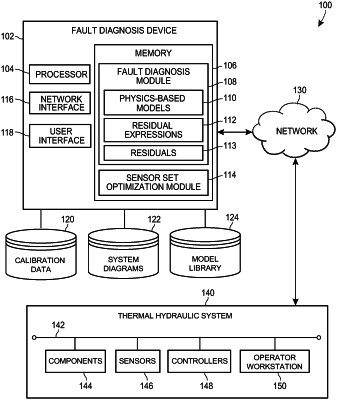| CPC G05B 23/024 (2013.01) [G06F 17/18 (2013.01); G07C 3/08 (2013.01)] | 19 Claims |

|
1. A method for diagnosing faults, the method comprising:
receiving, by one or more processors, a description of a component of a thermal hydraulic system, the description indicating:
(i) a type of the component,
(ii) connections between the component and other components of the thermal hydraulic system, an
(iii) sensor information including, for each sensor of one or more sensors of the component, a type of the sensor and a location of the sensor;
constructing, by the one or more processors without using measurements, one or more physics-based models describing operation of the component based on one or more physical conservation laws, the one or more physics-based models including one or more unknown parameters;
evaluating, by the one or more processors, whether the one or more sensors indicated in the sensor information are sufficiently numerous and sufficiently located to calibrate the one or more physics-based models;
selecting, by the one or more processors, a physics-based model from the one or more physics-based models based on the evaluating;
receiving, by the one or more processors, historical measurements captured by the one or more sensors of the component of the thermal hydraulic system during a first time period while the thermal hydraulic system is operating;
calibrating, by the one or more processors, the physics-based model by calculating the one or more unknown parameters using the historical measurements to produce a calibrated model specific to the component and to the thermal hydraulic system;
receiving, by the one or more processors, sensor measurements captured by the one or more sensors at a time instance while the thermal hydraulic system is operating, the time instance occurring after the first time period;
calculating, by the one or more processors, residuals corresponding to differences between measurements predicted by the calibrated model and the sensor measurements;
determining, by the one or more processors, based on a non-zero residual of the calculated residuals, that a fault, of the component or of a sensor of the one or more sensors, is present at the time instance;
generating, by the one or more processors, an alert indicating that the fault is present in the component or the sensor;
determining, by the one or more processors, an action to address the fault, the action comprising (i) shutting off the component or the sensor or (ii) redirecting flow away from the component or the sensor; and
performing, by the one or more processors, the action to address the fault by sending a control instruction to a controller of the thermal hydraulic system.
|